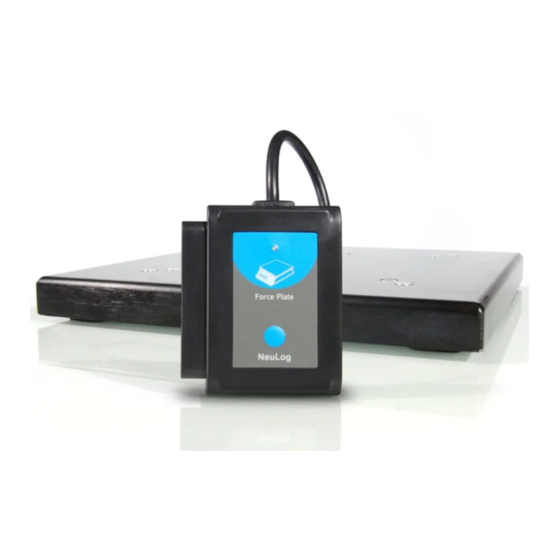
Advertisement
Quick Links
NeuLog force plate logger sensor
NUL-225
The NeuLog force plate sensor can be used for any science experiment which
involves both constant and changing forces such as in the fields of Physics,
Physiology, Mechanics, Biomechanics, etc.
The sensor comes pre-calibrated so you can start experimentation right out of the box
using this guide.
The sensor can easily be reset to zero at any time.
Among hundreds of possible experimental subjects that can be performed with the
NUL-225 sensor are: Newton's Laws of Motion, kinetic and potential energy,
gravitational force strength, impulse, elastic and inelastic collisions, and many more.
This sensor measures force in both the push and pull directions.
The force sensor's measurement unit is:
Newton (N): The SI unit of force.
2
1 N = 1 kg×m/s
Reset to zero:
The force plate sensor comes pre-calibrated however, after use you may find that the
sensor is slightly off or you may want to run an experiment that requires zeroing the
sensor with a constant applied force to it.
To zero the sensor:
1.
Connect the NUL-225 force plate sensor to a computer/tablet/smart device
following one of the guides below.
2.
Open the NeuLog application.
When your sensor has been detected click on the force plate "Module setup"
3.
button located in the module box (on the left side of your screen).
4.
Remove all weight from the sensor and click reset to zero your force plate
sensor.
5.
Your force plate sensor is now reset to zero.
NEULOG FORCE PLATE LOGGER SENSOR GUIDE
Note: You can zero the scale with a constant force being applied to it to set that value
as your new "zero". This is also used to eliminate the "Tare".
Quick start procedure:
PC or Mac Computer
Materials needed:
NUL-225 Force Plate Sensor
USB-200 USB Module
USB to mini USB cable (included with the USB-200 module)
Your force sensor needs to be connected to a USB-200 module. The USB-200
module then connects to a computer via a USB to mini-USB cable. Please note that
you cannot plug the force sensor directly into the computer.
The browser based application can be downloaded for free at
well as a full application user guide.
Choose "Downloads" on the main menu and then choose "Software and Application".
Procedure:
1.
Install the NeuLog application.
2.
Connect the USB-200 module to the PC or Mac.
3.
Connect the force plate sensor to the USB-200 module (they directly plug
together).
4.
Open the NeuLog application by clicking on the shortcut on the screen.
5.
Once a force plate sensor module box appears on the left side of the screen the
probe has been automatically identified and you can begin experimentation.
If the force plate sensor is not automatically identified, click the "Search for
6.
sensors" icon to find the sensor.
Click on the "On-line experiment" icon; this will open a graph below.
7.
Click on the "Module setup" button located in the force plate sensor module box
8.
to change the sensor's settings if need be.
9.
Click on the "Experiment setup" icon to change the experiment settings if need
be (experiment duration for example).
10.
The force plate sensor will give a live reading in the module box to the left of the
screen while plugged in.
To run an experiment and collect data click the "Run experiment" icon.
11.
To end data collection early, click the "Stop experiment" icon.
12.
www.NeuLog.com
as
Advertisement

Subscribe to Our Youtube Channel
Summary of Contents for NeuLog NUL-225
- Page 1 “zero”. This is also used to eliminate the “Tare”. NUL-225 Quick start procedure: The NeuLog force plate sensor can be used for any science experiment which involves both constant and changing forces such as in the fields of Physics, PC or Mac Computer Physiology, Mechanics, Biomechanics, etc.
- Page 2 NeuLog WiFi network which will stream the NeuLog data Click on the "Experiment setup" icon to change the experiment settings if need to a device of your choosing. Once your device is wirelessly connected to the NeuLog be (Experiment duration for example).
- Page 3 In order to find the science experiments, choose "Experiments" on the main Connect the USB-200 to a PC, Mac, tablet, or smart device. menu of the NeuLog website, then choose "Physics", "Chemistry", "Biology" or Connect the force plate sensor to a USB-200 module (they directly plug "Environmental Science".
- Page 4 The philosophy behind NeuLog’s plug and play technology is based on each sensor’s ability to store its own data due to an internal flash memory chip and micro-controller in each plastic NeuLog body. This technology allows the sensor to collect and then store the digital data in the correct scientific units ( F, Lux, %, ppm, for example).













Need help?
Do you have a question about the NUL-225 and is the answer not in the manual?
Questions and answers